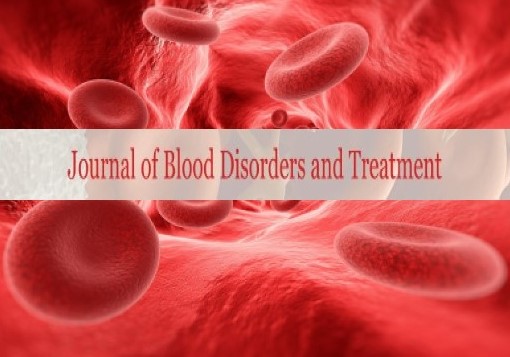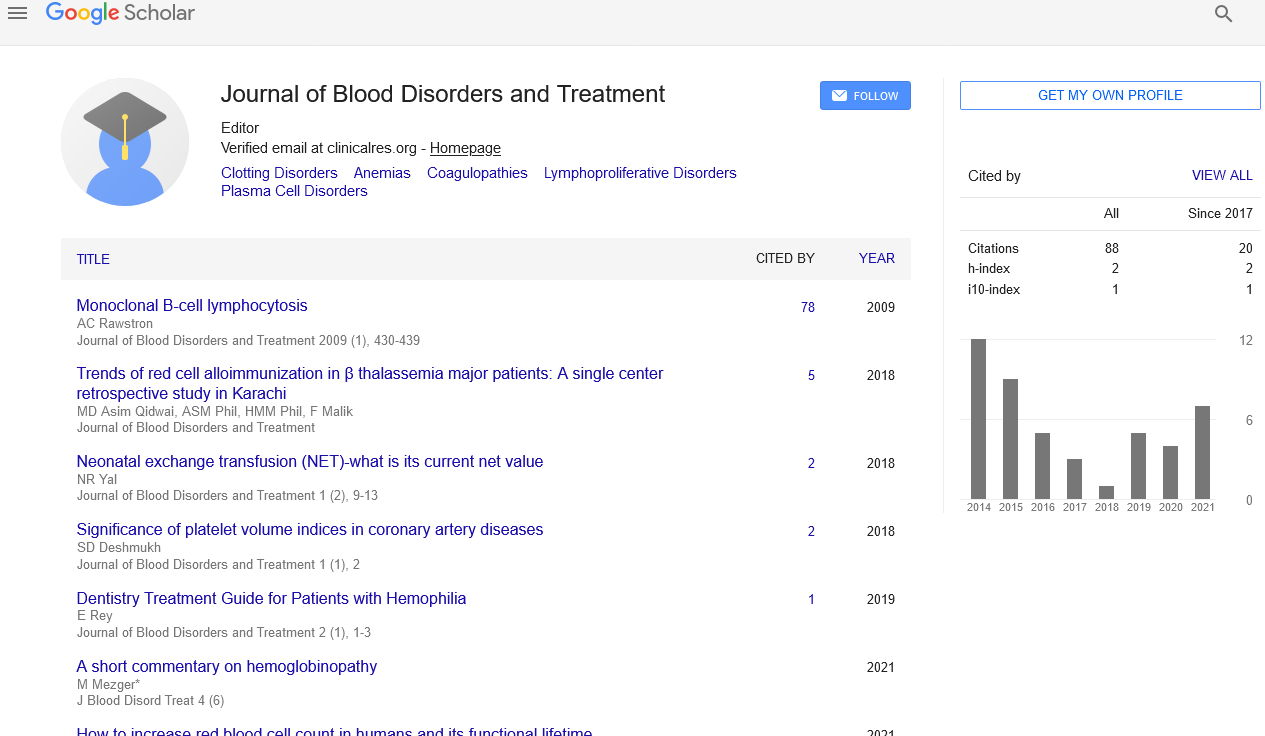Antithrombin deficiency
Received: 04-Sep-2022, Manuscript No. puljbdt-23-6215; Editor assigned: 06-Sep-2022, Pre QC No. puljbdt-23-6215 (PQ); Accepted Date: Sep 20, 2022; Reviewed: 10-Sep-2022 QC No. puljbdt-23-6215 (Q); Revised: 12-Sep-2022, Manuscript No. puljbdt-23-6215 (R); Published: 30-Sep-2022, DOI: 10.37532/puljbdt.2022.5(5).05
Citation: Collins A. Antithrombin deficiency. J. Blood Disord Treat. 2022;5(5):05.
This open-access article is distributed under the terms of the Creative Commons Attribution Non-Commercial License (CC BY-NC) (http://creativecommons.org/licenses/by-nc/4.0/), which permits reuse, distribution and reproduction of the article, provided that the original work is properly cited and the reuse is restricted to noncommercial purposes. For commercial reuse, contact reprints@pulsus.com
Abstract
Antithrombin (AT; Antithrombin III) deficiency is described as an AT activity level that is consistently less than 80% of normal (or the lower limit of the assay's reference range). It can be inherited or acquired. Some patients may experience a higher chance of thromboembolism due to AT deficiency. Replacement therapy is now feasible thanks to the availability of plasma-derived AT concentrates and recombinant AT, but their authorised use is only for people who have hereditary AT deficiency.
Keywords
Thromboembolism; Antithrombin; Plasma
Introduction
Blood blockages are more likely to form in people with hereditary antithrombin deficiency, also known as antithrombin III deficiency or AT III deficiency. People who have this disease frequently develop blood clots of two types: those that lodge in the lungs and those that form in the deep veins of the legs (Deep Vein Thrombosis, or DVT). One or more clots will form in the lifetime of about 50% of people with hereditary antithrombin deficiency, typically after adolescence. Pregnancy, the use of oral contraceptives, surgery, getting older, and a dearth of movement are all things that could make clotting more likely. Genetic changes in the SERPINC1 gene cause hereditary antithrombin deficiency, which is usually inherited in an autosomal dominant manner. A blood clot (thrombus) inside a vein is possible in people with antithrombin insufficiency (thrombosis). Typically, the first thrombotic incident happens before the age of 40. A group of blood platelets is called a thrombus.
Autosomal dominant inheritance is the mode of inheritance for hereditary antithrombin insufficiency. When only one copy of an altered gene is required for the illness to manifest, dominant genetic disorders result. Such an individual is referred to as a heterozygote. But not everyone with the changed gene will experience a blood clot. This varies clinical penetrance, according to geneticists. Antithrombin deficiency is a condition that has varying clinical penetrance and is autosomal dominant. Occasionally, a new mutation in the affected person can cause the altered gene, but this is extremely uncommon. For each pregnancy, there is a 50% chance that the altered gene will be passed from the affected partner to the foetus. Both men and women are at the same level of danger.
While new AT deficiency frequently does not inherited. AT deficiency raises the risk for blood clots. AT deficiency has two main causes: an inherited deficit caused by a genetic mutation, and an acquired deficiency brought on by another illness. A person may also experience temporary low antithrombin levels due to a number of conditions, but once the condition has passed, levels return to normal. Antithrombin levels may briefly be low if detected during an acute clot or while the patient is taking heparin. However, once the patient has recovered from the severe clot (within a few days to weeks) or when heparin is stopped, they usually go back to normal.
Knowing this is crucial to avoiding being misdiagnosed with "AT deficiency" if low levels are discovered. Sometimes these competing causes make it challenging to make a conclusive diagnosis of a hereditary deficiency. It is always recommended to perform additional testing later to confirm a low level in order to arrive at a final diagnosis. Occasionally, family testing is required to distinguish between hereditary and acquired deficiencies. Any patient with the diagnostic of "AT deficiency" would be wise to check the results to make sure they weren't based on a low level discovered during an acute clot. When someone is taking warfarin, their AT levels can occasionally rise. Men and women both experience inherited AT deficit on a regular basis. A person chance of blood clots is influenced by a variety of variables, including their level and type of deficiency, their family history of clots, and other clot-related risk factors (such as pregnancy or oestrogen therapy, surgery or immobility, obesity, smoking and others). The hereditary condition known as inherited AT deficiency is rare. It affects 0.22% to 0.02% of the general population, or 1 in 500 individuals to 5000 individuals. Therefore, there could be 60,000 cases to 600,000 cases of this condition in the United States. It is inherited in a dominant pattern, so if either parent has the disorder, there is a 50% possibility that the child will as well. Equally affected are both males and women. Blood type does not matter. A individual is heterozygous if they have one mutated or defective antithrombin gene. A person is homozygous if they inherit two damaged (mutated) alleles. The foetus typically dies before birth in homozygous individuals, which causes a miscarriage. The various kinds of hereditary AT deficiencies are categorised as "type I" and "type II" deficiencies.





